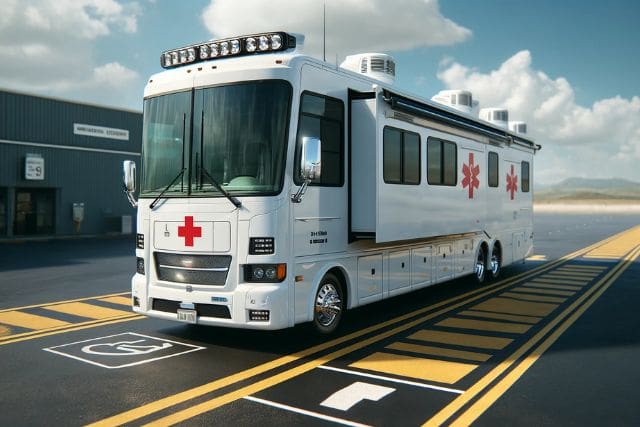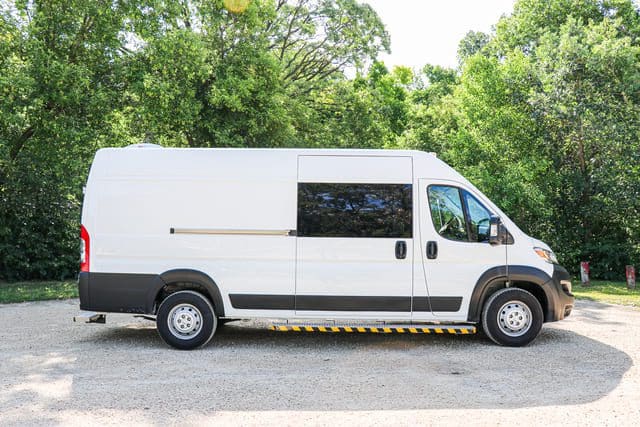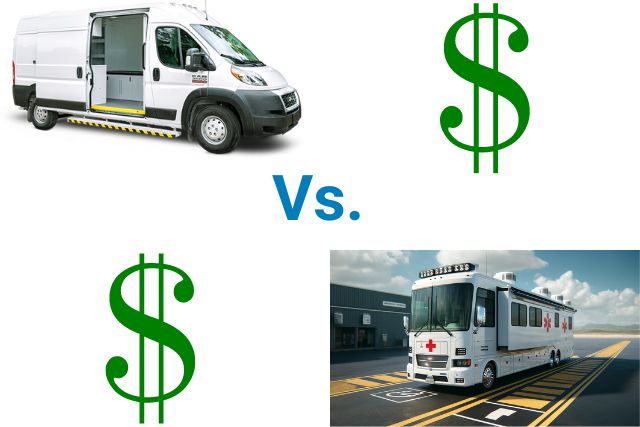Is your organization currently trying to figure out whether to purchase a mobile medical RV vs. a mobile medical van for its healthcare mission? If so, one of the most important things you’ll need to know is how much you can expect to pay. Not having a clear idea of the cost can lead to:
- Choosing a vehicle that exceeds your budget
- Prioritizing features over affordability
- Overlooking long-term maintenance, insurance, or customization costs
At AVAN Mobility, we don’t like seeing people across the U.S. struggling to navigate barriers like living in remote areas or a lack of finances, just to receive proper healthcare. That’s why we’ve been manufacturing mobile medical vans so organizations like yours can help out. We’re all about helping people help people.
As you read this article, you’ll learn more about the cost differences between a mobile medical RV vs. a mobile medical van. Knowing these cost differences will help you make the right decision for what vehicle you’ll be choosing in the future. Keep in mind that all prices in this article are estimates, and the final cost will vary.
How much does a mobile medical RV cost?

The cost of a mobile medical RV typically ranges from $200,000 to $500,000 or more, depending on customization and specifications.
Several factors play a role in the costs:
Vehicle size and features:
- The size of the RV plays a big role in determining the cost. In most cases, a 25-foot RV won’t be as expensive as a 50-foot RV.
- RVs with advanced medical features will cost more, and designing your RV for specific healthcare services can impact the overall price. For example, if you’re going to be running a mobile dental RV clinic, you can expect to be paying more for it than a basic healthcare mobile medical RV since you need expensive dental equipment.
Technology and innovation:
- The use of cutting-edge medical technologies is another important factor that influences the costs. Going back to the example above, something like a mobile dental RV clinic would require:
-
- A dental chair
- X-ray equipment
- Sterilization tools
- Dental drills
- Digital imaging systems
- Suction systems
Customization and specialization:
- How much are you planning on customizing your mobile medical RV? The degree of customization and specialization adds to the overall cost.
- Customization ensures that the vehicle fits perfectly with the unique needs and goals of your organization. For example, an RV with 4 rooms for patients will be more expensive than one with only 2.
- Some other customization features that can drive up the cost of your mobile medical RV include:
-
- High-quality finishes
- Security features, such as surveillance systems
- Exterior features, such as storage compartments, awnings, and ramps/lifts
- Climate control systems, soundproofing, and comfortable seating
Vehicle maintenance and upkeep:
- Regular maintenance and upkeep contribute significantly to the total cost of a mobile medical RV.
- Ensuring that the vehicle is in optimal working condition involves routine checks, servicing, and addressing any wear and tear.
How much does a mobile medical van cost?

On average, the cost of a mobile medical van ranges between $125,000 to $225,000. This cost estimate is based on a chassis of 159 inches. The chassis is the base of the vehicle that includes the frame, engine, transmission, wheels, and other supportive parts of the van’s body.
Let’s take a look at a few things that influence the cost of a mobile medical van.
Type of van:
- The selection of the van chassis is a large factor that impacts costs.
- Different van models and brands come with different base prices.
Customization and features:
- The level of customization extends beyond medical features and impacts the price of the van. Read our article on mobile medical van customization to see what’s possible.
- The materials used in the construction of the mobile medical unit also contribute to costs. Our vehicles at AVAN Mobility are made with aluminum upfits for increased durability. Aluminum is a great pick for mobile medical vans because it doesn’t rust easily. Its smooth surface makes it easier to clean, and it doesn’t hold onto dirt and germs as much as other materials.
Medical equipment and components:
- The inclusion of custom medical equipment, stretchers, and seating options plays a big role in determining costs. Individual seating options can cost up to $1,500 per seat.
- Specialized components like heating and air conditioning systems, lighting setups, patient beds, and desk space contribute to the overall expense.
Interior finishing:
- The choice of interior finishing materials influences the aesthetic appeal and durability of the mobile medical van.
- Different finishing options come with varying price points. Laminate or plastic may be cheaper, but aren’t as durable as aluminum.
Fridge and sink options:
- Including a fridge and sink in the van adds to the convenience and functionality but also affects costs.
Mobile medical RV vs. mobile medical van: Which one should you choose and why?
Choosing between a mobile medical RV vs. a mobile medical van requires careful consideration. Let’s look at some key factors, starting with your budget.
1. Budget considerations
Mobile medical van: If you’re keeping an eye on your budget and your organization is tight financially, a van is your go-to. Compared to an RV, it’s a cost-effective option that allows you to kickstart your healthcare services and test the waters without putting a huge strain on your finances.
Mobile medical RV: Now, the RV demands a much bigger budget and investment. It’s a lot larger, and that main factor makes it a pricier option. While it offers more space, you need to weigh whether that feature aligns with your mission and budget.
Keep in mind that mobile medical RVs also entail higher long-term expenses than mobile medical vans. They cost more to upkeep and maintain, and that fact can’t be ignored. Some of the factors that cause the increased expenses with mobile medical RVs include:
- RVs need bigger tires to support their weight, and they cost more to buy and maintain.
- RV insurance is pricier because they’re bigger and more valuable.
- RVs use more gas than vans because they’re heavier.
- RV maintenance is often more complex and costly than vans’.
- Storing and parking RVs is more expensive due to their size.
- RVs lose value faster than vans, making them costlier in the long run.
2. Size and space requirements
Mobile medical van: Vans are compact and small, making them perfect for focused missions with a smaller team or fewer tools.
Mobile medical RV: RVs, on the other hand, are spacious – maybe more than you need. Assess if the extra room aligns with your team size and equipment requirements.
3. Maneuverability and accessibility
Mobile medical van: Vans are agile and swift, fitting into tight spots and adapting to various communities. They’re like a versatile tool that’s always ready to move to provide healthcare at the next location. If you’ve ever driven a short vehicle before, you know how easy they are to drive and park compared to longer and larger ones.
Mobile medical RV: RVs, while impressive, their size makes them less flexible. Picture trying to navigate a long RV through twisty roads in remote communities or cramped parking lots in packed cities. Consider how often you need to change locations and reach different communities because if it’s frequent, this could become cumbersome with a big medical RV.
4. Targeted vs. comprehensive services
Mobile medical van: Vans are efficient for specific tasks like vaccinations or remote healthcare. They’re perfect for targeted healthcare and excel in what they’re designed for.
Mobile medical RV: The size of RVs might offer a bit of flexibility in terms of the various services you can provide. But, you need to think about if you really need that level of versatility for your current program.
Think of it as having a tool with multiple functions – cool, but maybe more than necessary. This also goes back to the startup and ongoing costs involved in your services. Bigger and broader services require a larger budget.
If you’re just starting a mobile medical program for the first time and still learning the field, a mobile medical RV might be going a bit overboard.
5. Community dynamics
Mobile medical van: Vans are adaptable and always on the move to meet changing community needs. It’s like having a tool that goes wherever it’s needed.
Mobile medical RV: Your organization needs to think if your mobile medical vehicle will be situated and fixed in communities for extended periods or constantly on the move. With the large size of RVs, they’re good at providing stability in one place, acting as a consistent healthcare resource.
Choosing between a mobile medical van and RV involves thinking about your budget, the size you need, how flexible you want your program to be, the specific services you provide, and your mobility requirements.
While RVs are impressive, mobile medical vans often fit the bill with their budget-friendliness, adaptability, and focused approach. Consider what tool aligns best with your healthcare mission to make your choice.
What’s next?
You most likely made it to this article while researching mobile medical RVs and mobile medical vans. Now that you know more about the cost differences between these vehicles you’re probably also beginning to consider various manufacturers. Check out these 2 articles:
- Summit Bodyworks vs. AVAN Mobility: A Comparison on Mobile Medical Van Manufacturers
- CGS Premier vs. AVAN Mobility
A lot of organizations we work with also have difficulty finding funding for starting their mobile medical program. Read our article on the top 6 ways to apply for grants for some assistance with that.
If you have any other questions about our mobile medical vans at AVAN Mobility, don’t hesitate to click the button below to talk to a mobility expert.




